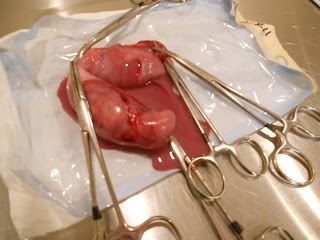Spay and Neuter. You've heard it all before. Let's review...
- You should spay (female) or neuter (male) your pet to avoid inadvertently increasing the homeless pet population. Nationwide there is an overload of unwanted pet animals. Humane shelters can't find homes for all the stray and surrendered dogs and cats out there already.
- Your pet should be "fixed" to prevent unpleasant behavioral issues such urine marking, roaming, aggression, vocalization and "in heat" behaviors.
- Spaying and neutering reduces or altogether eliminates certain dangerous medical conditions. Surgical removal of the testes, uterus and ovaries obviously means your pet will not develop cancer in these organs. Risk of mammary cancer (especially in dogs) is reduced dramatically with spaying before the onset of puberty. Life threatening uterine infections are a common preventable condition as well, and that's what I want to talk about today!
I have seen far too many unspayed dogs and cats presented for life threatening uterine infections. These animals are typically older and
usually have never been bred. Recently, I was presented with a senior kitty who had had one litter of kittens years ago, but was so nervous at the vet she had never been spayed after an initial vaccination series. Now the owner noticed bloody discharge from the vulva. The kitty, Tina
*, was not showing signs of a urinary tract infection such as frequently straining to pass small amounts of urine. The owner was certain Tina could not be pregnant, but she had not had normal heat behavior for some time. My physical examination confirmed that Tina had an open pyometra, or uterine infection.
 |
A feline pyometra after surgery. An incision was made into
one uterine horn to visualize (and smell!) the contents,
a mixture of blood, pus and bacteria. |
There are two types of pyometra. An "open" pyometra means the cervix is dilated and the infection can leak out somewhat. A "closed" pyometra means the cervix is tightly closed, and pus builds up inside the uterus without any outlet. Either type of pyometra is bad news and requires immediate aggressive action (nearly always surgery). However, a closed pyometra is often worse for several reasons. Veterinary intervention may be delayed with closed pyometra because it may be harder for owners to identify a problem with their pet. Aside from the foul discharge associated with open pyometra other symptoms of a pyometra are vague and sometimes subtle. A pet suffering from pyometra may have decreased appetite, vomiting, diarrhea or lethargy. A classic sign is drinking more water and urinating more, but this is again a non-specific symptom associated with
many serious problems commonly seen in older pets. Because animals with closed pyometra are usually not presented to the veterinarian as early in the disease, these pets are usually much, much sicker when they finally are diagnosed. Tragically, some of these pets have a ruptured uterus and are septicemic with infection in their bloodstream by this point. Many owners elect humane euthanasia rather than pursue treatment.
 |
Tina remained in intensive care on IV fluids after
surgery to support her internal organ function during
recovery. |
Fortunately for Tina, her cervix was open and her owner wasted no time seeking veterinary care. After running comprehensive blood work to identify if Tina had any other underlying diseases, she was hospitalized overnight on intravenous fluids and started on antibiotics. The next morning she had the surgery that I wish she'd had done years ago -- she was spayed. A pyometra spay is more complicated, more risky and more expensive than a spay on a young healthy animal for obvious reasons. The uterine horns are filled with pus. If the uterus ruptures (which is more likely when the cervix is closed and the uterus is like an over-inflated balloon ready to pop), there is horrible bacterial contamination of the entire abdomen! Plus the animal is often systemically very ill and so requires aggressive supportive care in the hospital before and after the surgery, and she may have a slow recovery at home.
The lesson here is prevention. As a veterinarian I hate seeing my clients struggle with the decision of whether to pursue costly treatment for their senior pet's pyometra or to euthanize her. I have seen numerous old dogs and cats go on to live many happy years after surgery for pyometra, so it is usually well worth the effort! Still it is cheaper and safer to spay your pet when she is young and healthy. Please avoid the heart-ache and financial burden that comes with waiting too long to spay.
* Name changed to respect owner privacy.


No comments:
Post a Comment